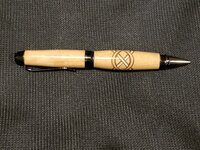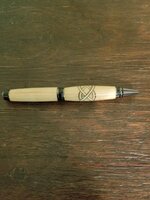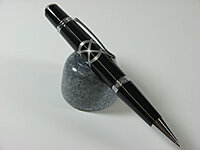Specifically, what I think Mal and I are trying to figure out is how
@duderubble got 4 unders and 4 overs. Seems like doing opposite sides might be the key to that. Intentional or not it is a very esthetically appealing look that I'd like to achieve and consistently duplicate. I haven't had an issue with the knots being off-center. I need to decide which is easier, sizing the insert to fit the kerf or cutting all the way through so that isn't an issue. JT, your comment about not clamping the ends makes sense. Your blank in the above picture was obviously made with the "not cut through" method and has the crisp lines with no gaps that
@duderubble achieved. Looking at that blank, on the side that's facing up it appears that the diagonal lines would end up under the horizontal lines.
I'd love to see how the above-pictured blank looks when it's turned. You and I are saying the same thing about glue lines (gaps) being caused by the blank bowing. I think I can fix that by making sure the inserts are an exact fit and, like you suggested, not clamp the ends. I'll also try the 1-2-4-3 idea. What do you mean by "but still cut in order"?
@duderubble, again, I was very impressed with your results as a first try so I was trying to take elements from various techniques and combine them to get a better result in the end. I know, as the expression goes, "I am trying to pick the fly s**t from the pepper" but I feel like I'm zeroing in on a good overall technique.



